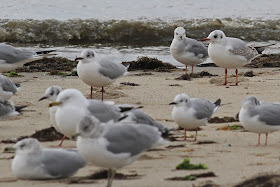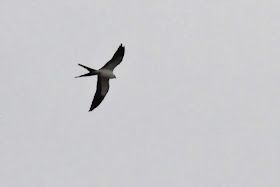In fall, Cape May's migration largely consists of songbirds and raptors through September and October, then seaducks from October into early December. But in spring it's a different package with herons and egrets, shorebirds, gulls, gannets and others coming into the picture. March might seem early to be thinking of spring migration, given that many sites have to wait until May before things really take off, but spring migration really does start this early in Cape May - and today certainly proved that, as you will see!
The first count made on 11th was typically quiet (though such days make for good comparison with the busy ones), yet produced some nice finds, including two Red-necked Grebes, three Great Egrets, four Laughing Gulls (yes, the early birds are heading into town now!), two Common Mergansers, two Wood Ducks and a Pine Warbler. The latter is always nice to report - watching songbird migrants coming in low over the waves and heading for cover behind the dunes is always exciting. On the 12th, Megan and I joined Tom and we logged a reasonable Canada Goose movement, a flurry of Northern Gannets coming out of the bay and a continuing pre-migration build up of Red-throated Loons in The Rips. Two Pine Warblers were noted and some interesting movements of songbirds saw parties of American Robins, Common Grackles and Red-winged Blackbirds making circuits around the point but seemingly not really heading anywhere.
Work beckoned after a time but, as the day progressed, it was becoming clear that spring was beginning to produce some interesting birds. An adult Little Gull gave many people the run-around as it toyed with us along the bayshore, seemingly showing up at random locations without a care for the fevered, would-be observer who had to negotiate the busy streets of Villas and Del Haven several times to keep pace with the sightings (and still it eluded many). A scattering of Laughing Gulls showed up from the ferry terminal northward, while Miami Beach in Villas attracted nearly 200 Bonaparte's Gulls, up to five Black-headed Gulls and - eventually - the Little Gull.
So birds are moving, spring is definitely making it's presence felt, though we now have another 36 hours or so of horribly cold weather again as I can hear the wind howling outside and areas north and west of us get yet more snow dumped on them. Take a rain check on birding tomorrow, then head this way to be part of Cape May Springwatch - let the counting commence!!
Though I titled this post '..and so it begins', this short series of photos from today will readily demonstrate to you that I could have subtitled it 'not the best photo I've ever taken' or 'what a gray day' (one for the Brits there!)....
For me, Springwatch started with this party of Red-breasted Mergansers, heading out of Delaware Bay this morning and beginning their long, northward journey. Cape May Point offers some great migration watching right through the spring period with birds often passing close along the shoreline [photo by Mike Crewe].
He the usurper waits in the wings... or summer parking lot gull meets winter parking lot gull. My first Laughing Gull of the year prepares to move in while a Ring-billed Gull contemplates heading out of town at the Cape May Ferry Terminal today [photo by Mike Crewe].
Lunchtime visits to Miami Beach are a must during March; this site has a sandbar, pushed up by the outflow of water from Fishing Creek, which is one of the last places to be covered by high tide. Check tide tables and visit on a rising tide to get the best from this place - here, a second calendar year and adult Black-headed Gull (check for red on the bills) mix in with Bonaparte's and Ring-billed Gulls [photo by Mike Crewe].
Today's prize for gull fans - a dapper, adult Little Gull. Note the completely black underwing with white trim and the rounded wingtips. Though most of the North American population of this species winters not far off our coastline, this is a surprisingly scarce species at Cape May with, typically, just one or two birds a year [photo by Mike Crewe].
Saving the best until last - and not wishing to blow my own trumpet, but... while shooting up to Miami Beach lunchtime today with Warren and Megan, I spotted this distinctive shape heading northward over Fishing Creek Road toward Cape May Airport. Checking the record books, this seems to constitute the earliest ever record of Swallow-tailed Kite for New Jersey and continues a recent trend of March records for the Cape May area [photo by Mike Crewe].




